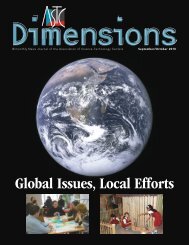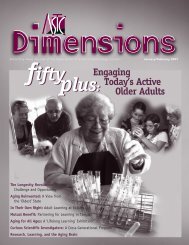Scientists Speak about Nano - Association of Science - Technology ...
Scientists Speak about Nano - Association of Science - Technology ...
Scientists Speak about Nano - Association of Science - Technology ...
You also want an ePaper? Increase the reach of your titles
YUMPU automatically turns print PDFs into web optimized ePapers that Google loves.
“highly relevant,” and prototypes have<br />
tended to be rated as “relevant” by<br />
50 percent <strong>of</strong> visitors or fewer. Some <strong>of</strong><br />
those perceived as least relevant may<br />
have suffered from poor execution in<br />
early versions. Relevance <strong>of</strong> topics has<br />
been addressed more aggressively in the<br />
round <strong>of</strong> exhibits that will be tested<br />
this year.<br />
When prototypes have been<br />
confusing, the confusion has tended<br />
to be related to usage, rather than<br />
concepts. The most challenging<br />
exhibits for visitors, in terms <strong>of</strong><br />
enjoyment, clarity, and the conveying<br />
<strong>of</strong> main messages, have been innovative<br />
experiences like the immersive<br />
digital interactives (IDIs).<br />
For example, when asked <strong>about</strong><br />
ease <strong>of</strong> use <strong>of</strong> an IDI that explores the<br />
properties <strong>of</strong> water at three scales,<br />
25 percent <strong>of</strong> visitors rated the experience<br />
at the lowest level. For another<br />
IDI, in which water molecules form a<br />
crystal when a visitor’s hand creates a<br />
nucleation point, <strong>about</strong> 80 percent <strong>of</strong><br />
visitors said there was something<br />
confusing or frustrating <strong>about</strong> the<br />
experience. Most <strong>of</strong> this frustration<br />
was related to usage and installation<br />
issues. The creation <strong>of</strong> successful and<br />
innovative nano experiences is a critical<br />
focus <strong>of</strong> upcoming work.<br />
Finally, we lack comparative information<br />
<strong>about</strong> the impact <strong>of</strong> different<br />
contexts. Comparative tests <strong>of</strong> the<br />
same content in different contexts<br />
(e.g., hands-on exhibits, media, IDIs,<br />
text, programs, forums) will allow us<br />
to better understand cost benefits and<br />
the best combinations <strong>of</strong> contexts for<br />
the complex, multidisciplinary nature<br />
<strong>of</strong> nanoscale science. ■<br />
Kirsten Ellenbogen is director <strong>of</strong><br />
evaluation and research in learning at<br />
the <strong>Science</strong> Museum <strong>of</strong> Minnesota, St.<br />
Paul. This article reports on evaluation<br />
conducted by Ellenbogen, Amy Grack<br />
Nelson, Saroeun Earm, Katonya<br />
Gillard, Amy Gramsey, Beth Janetski,<br />
Stephanie Nelson, Dave Ordos, Murphy<br />
Pizza, Stacie Redemacher, and Patrick<br />
Smith. It also draws on the expertise <strong>of</strong><br />
lead NISE Net exhibits staff, particularly<br />
Sue Koch and Paul Martin.<br />
Being asked to reflect on nanotechnology<br />
gives me pause—mostly<br />
because this field is still in its genesis,<br />
and there isn't a consensus yet on what<br />
it is. Nevertheless, I believe nanotechnology<br />
holds many opportunities,<br />
both conventional and unconventional.<br />
Given the confusion over what it is,<br />
I’ll share a definition I use: <strong>Nano</strong>technology<br />
is “the study <strong>of</strong> the small and<br />
curious.” By “small,” I mean things as<br />
small as 1/80,000th to 1/100,00th the<br />
thickness <strong>of</strong> your hair. By “curious,” I<br />
mean that materials act differently<br />
and have different properties at the<br />
nanoscale than they do at our scale.<br />
This definition alone provides learning<br />
opportunities. With nanotechnology,<br />
we can teach scale. That covers the<br />
“small” part <strong>of</strong> the definition. The second<br />
part <strong>of</strong> the definition—the “curious”<br />
part—requires a bit more imagination.<br />
One way to explain it is to imagine<br />
a machine that can shrink things. If a<br />
hamburger is placed inside, it will continue<br />
to become smaller and smaller.<br />
But as we reach a nano-burger, suddenly<br />
it turns into a hot dog—the properties<br />
have completely changed.<br />
This power <strong>of</strong> nanotechnology at<br />
work is evidenced by gold. At our scale,<br />
gold is harmless and can be used as<br />
jewelry and tooth fillings. But gold<br />
nanoparticles are reactive and can be<br />
used as catalysts to remove pollution.<br />
Old things act in a new way when made<br />
very, very small.<br />
Interestingly, nanotechnology could<br />
be used to build trust between the<br />
public and scientists. If researchers are<br />
willing to be vulnerable, we can use<br />
nanotechnology to demonstrate the<br />
business <strong>of</strong> science. More specifically,<br />
we could admit that sometimes we<br />
build a tool but don’t yet know its capabilities<br />
and applications, both positive<br />
and negative.<br />
Although some applications, like<br />
stain-resistant products, are already in<br />
the market, and others, like nanomedicine<br />
and water filtration, are still on the<br />
horizon, we continue to develop all <strong>of</strong><br />
them. By letting our guard down and<br />
ASTC Dimensions • January/February 2008 13<br />
<strong>Scientists</strong> <strong>Speak</strong> <strong>about</strong> <strong>Nano</strong> . . .<br />
<strong>Nano</strong>technology as a Catalyst for Change<br />
By Ainissa G. Ramirez<br />
showing the unknowns and how we<br />
discover things, researchers may create<br />
a new science narrative, generate more<br />
public confidence, and demystify science<br />
by adding a human element to it.<br />
The science <strong>of</strong> the very, very small<br />
can lead to other big opportunities as<br />
well. In particular, it can enable a paradigm<br />
shift in how we teach science.<br />
Throughout history, broad changes in<br />
science education have been catalyzed<br />
by political thrusts: World War II and<br />
Sputnik ushered in the golden age <strong>of</strong><br />
physics; Brown v. Board <strong>of</strong> Education<br />
ushered in equality in the classroom.<br />
Lacking these political imperatives,<br />
which can limit creativity, nanotechnology<br />
<strong>of</strong>fers a platform to try new<br />
methods for engaging audiences and<br />
improving science literacy. We can<br />
experiment and diversify our portfolio<br />
for getting the word out—especially to<br />
groups like non-experts, girls, and<br />
underrepresented communities—by<br />
adopting tools like YouTube, television,<br />
video games, and hip-hop, and by frequenting<br />
malls, churches, and science<br />
salons. <strong>Nano</strong>technology can be a<br />
catalyst for innovation in science and<br />
science education alike. It can change<br />
not only how we think <strong>about</strong> materials<br />
but also how we engage audiences<br />
along the way. ■<br />
An associate pr<strong>of</strong>essor <strong>of</strong> mechanical<br />
engineering at Yale University, NISE<br />
Net advisor Ainissa G. Ramirez (ainissa<br />
@mit.edu) recently spent a semester as<br />
a visiting pr<strong>of</strong>essor at the Massachusetts<br />
Institute <strong>of</strong> <strong>Technology</strong>.





